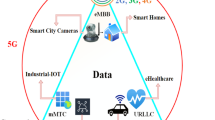Abstract
This paper addresses the analysis of a two-way semi-blind amplify-and-forward (AF) relay network, in which the relay node requires partial instantaneous channel state information (CSI) to amplify the received signals. First, we derive the expression of end-to-end signal-to-noise ratio in dual-hop transmissions over independent and not necessarily identically distributed Rayleigh fading channels. Based on the opportunistic AF selection relaying, we define bounds of some metrics such as average sum-rate and outage probability. Furthermore, we provide exact and approximate expressions for the average symbol error rate. The obtained results show that the performance of the proposed system decreases slightly while the processing complexity is reduced significantly compared to those of CSI-assisted AF relay schemes. In order to prove the exactness of the proposed analysis, a selection of numerical results is provided.






Similar content being viewed by others
References
Sendonaris A, Erkip E, Aazhang B (2003) User cooperation diversity—part I: system description. IEEE Trans Commun 51:1927–1938. doi:10.1109/TCOMM.2003.818096
Laneman JN, Tse DNC, Wornell GW (2004) Cooperative diversity in wireless networks: efficient protocols and outage behavior. IEEE Trans Inf Theory 50(12):3062080. doi:10.1109/TIT.2004.838089
Kramer G, Gastpar M, Gupta P (2005) Cooperative strategies and capacity theorems for relay networks. IEEE Trans Inf Theory 51(9):3037–3063
Hu H, Yanikomeroglu H, Falconer DD, Periyalwar SRange extension without capacity penalty in cellular networks with digital fixed relays. In: Proceedings of IEEE global telecommunications conference (GLOBECOM2004). Dallas, pp 3053–3057
Hadj Alouane W, Hamdi N, Meherzi S (2012) Accurate BEP of adaptive demodulate-and-forward relaying over Rayleigh fading channels. In: 17th IEEE symposium on computers and communication (ISCC)
Lagrange X (2011) Performance analysis of HARQ protocols with link adaptation on fading channels. Ann Telecommun 66(11–12):695–705
Hadj Alouane W, Hamdi N, Meherzi S (2012) Analytical BEP expressions of incremental and selective ADmF protocols in cooperative wireless networks. In: 20th IEEE telecommunications forum (TELFOR), pp 202–205
Hadj Alouane W, Hamdi N, Meherzi S (2012) Closed-form BEP of demodulate-and-forward using two-relay over Rayleigh fading environments. In: 3rd international conference on the network of the future (NoF 2012)
Talha B, Ptzold M (2010) Mobile-to-mobile fading channels in amplify-and-forward relay systems under line-of-sight conditions: statistical modeling and analysis. Ann Telecommun 65(7–8):391–410
Amara S, Boujema H, Hamdi N (2009) SEP of cooperative systems using amplify and forward or decode and forward relaying. In: 17th European signal processing conference, Glasgow
Rahima S, Hamdi N (2012) Generalized beamforming (GBF) for MIMO amplify-and-forward relaying. In: 8th international wireless communications and mobile computing conference (IWCMC-2012), pp 185–188
Wu Z, Yang H-B (2011) Power allocation of cooperative amplify-and-forward communications with multiple relays. In: IEEE international conference on communications (ICC)
Emamian V, Anghel P, Kaveh M (2002) Outage probability of a multiuser spatial diversity system in a wireless networks. In: Proceedings of the IEEE vehicular technology conference. Vancouver, pp 573–576
Hasna MO, Alouini M-S (2003) End-to-end performance of transmission systems with relays over Rayleigh-fading channels. IEEE Trans Wirel Commun 2(6):1126–1131
Xia M, Wu Y-C, Aissa S (2012) Exact outage probability of dual-hop CSI-assisted AF relaying over Nakagami-m fading channels. IEEE Trans Signal Process 60:5578–5583
Laneman J, Wornell G (2003) Distributed space-time-coded protocols for exploiting cooperative diversity in wireless networks. IEEE Trans Inf Theory 49(10):2415–2425
Hasna MO, Alouini M-S (2003) End-to-end performance of transmission systems with relays over Rayleigh-fading channels. IEEE Trans Wirel Commun 2(6):1126–1131
Pham TT, Nguyen HH, Tuan HD (2010) Power allocation in orthogonal wireless relay networks with partial channel state information. IEEE Trans Signal Process 58(2):869–878
Ferdinand NS, Jayasinghe U, Rajatheva N, Latva-aho M (2012) Impact of antenna correlation on the performance of partial relay selection. EURASIP J Wirel Commun Networking 2012:261. doi:10.1186/1687-1499-2012-261
Chau YA, Al-Harbawi MCooperative diversity with a new incremental relay protocol and its performance evaluation. In: International conference on image and information processing (ICIIP 2012), vol 46. IPCSIT
Suraweera HA, Michalopoulos DS, Karagiannidis GK (2009) Semi-blind amplify-and-forward with partial relay selection. Electron Lett 45(6):317–319
Hasna MO, Alouini M-S (2004) A performance study of dual-hop transmissions with fixed gain relays. IEEE Trans Wirel Commun 3(6):1963–1968
Larsson P, Johansson N, Sunell KE (2006) Coded bi-directional relaying. In: Proceedings of the IEEE vehicular technology conference (VTC06-Spring). Australia, pp 851–855
Rankov B, Wittneben A (2007) Spectral efficiency protocols for halfduplex fading relay channels. IEEE J Select Areas Commun 25(2):379–389
Rankov B, Wittneben A (2005) Spectral efficient signaling for half-duplex relay channels. In: Proceedings of the asilomar conference on signals, systems, and computers. Pacific Grove
Song L (2011) Relay selection for two-way relaying with amplify-and-forward protocols. IEEE Trans Veh Technol 60:1954–1959
Hwang K-S, Ko Y-C, Alouini M-S (2009) Performance bounds for two-way amplify-and-forward relaying based on relay path selection. In: 69th IEEE vehicular technology conference. VTC Spring
Hussain SI, Hasna MO, Alouini M-S (2012) Performance analysis of selective cooperation with fixed gain relays in Nakagami-m channels. Phy Commun 5(3):272–279
Anghel PA, Kaveh M (2004) Exact symbol error probability of a cooperative network in a Rayleigh-fading environment. IEEE Trans Wirel Commun 3(5):1416–1421
Gradshteyn IS, Ryzhik IM (1994) Table of integrals, series, and products, 5th edn. Academic, San Diego
Abramowitz M, Stegun IA (1970) Handbook of mathematical functions with formulas, graphs, and mathematical tables, 9th edn. Dover, New York
Hwang K-S, Ko Y-C, Alouini M-S (2011) Performance analysis of two-way amplify and forward relaying with adaptive modulation over multiple relay network. IEEE Trans Commun 59(2):402–406
Author information
Authors and Affiliations
Corresponding author
Rights and permissions
About this article
Cite this article
Alouane, W.H., Hamdi, N. & Meherzi, S. Semi-blind amplify-and-forward in two-way relaying networks. Ann. Telecommun. 69, 497–508 (2014). https://doi.org/10.1007/s12243-013-0390-7
Received:
Accepted:
Published:
Issue Date:
DOI: https://doi.org/10.1007/s12243-013-0390-7




